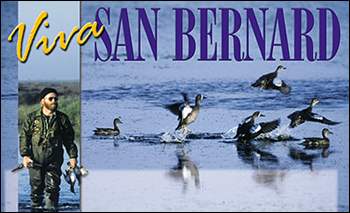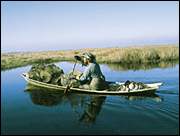
Situated near the mouth of the San Bernard River is what many consider to be the most user-friendly and productive National Wildlife Refuge of them all.
By Shannon Tompkins
There is little evidence that Stephen F. Austin was an inveterate duck hunter. But if he had been, it would go a long way toward explaining why he picked the country along the lower Brazos River as the center for his colony 180 or so years ago. Austin plopped the Old 300 right on the edge of some of the finest waterfowl wintering habitat on the Texas coast.
West and south of the high ground along the lower Brazos, where Austin's Colony set up shop, stretches about 100 miles of unbroken coastal marsh and prairie -- all the way to the mouth of the Colorado River. For eons, that country has served as wintering habitat for hundreds of thousands of migrating waterfowl.
It still does.
 The stretch of marshlands from West Galveston Bay to East Matagorda Bay holds five large government-controlled tracts managed to provide some of the best waterfowl habitat in the nation. And the birds -- snow geese to blue-winged teal, sandhill cranes to pintails -- come by the tens of thousands each autumn to take advantage of the plenitude. The stretch of marshlands from West Galveston Bay to East Matagorda Bay holds five large government-controlled tracts managed to provide some of the best waterfowl habitat in the nation. And the birds -- snow geese to blue-winged teal, sandhill cranes to pintails -- come by the tens of thousands each autumn to take advantage of the plenitude.
So, too, do waterfowl hunters.
With the marshes located less than a 2-hour drive from Houston -- the state's largest city and the center of Texas' highest concentration of waterfowlers -- the country between the Brazos and Colorado rivers draws considerable interest from avid hunters. Those hunters have a lot from which to choose. The region offers perhaps the highest concentration of first-rate public waterfowl hunting areas on the coast.
On the north end, there's the Brazoria National Wildlife Refuge and Peach Point Wildlife Management Area bracketing Freeport. On the other end, near East Matagorda Bay, there's Big Boggy NWR and Mad Island WMA. And right in the middle, situated near the mouth of the San Bernard River, is what many consider to be the most user-friendly and productive of all the San Bernard National Wildlife Refuge.
The San Bernard NWR has for years offered four separate public hunting areas totaling nearly 9,000 acres. Three of those areas are open to public waterfowl hunting all day, each day of the duck and goose seasons, and there is no fee charged for access.
One area, the Sargent Permit Hunting Area, is open to limited hunting on a permit-only basis three days a week during duck season and Saturdays during the goose-only season. The fee charged there is $10 per person, with each group getting an assigned compartment to themselves.
This hunting season, refuge staff hope to open the fifth public waterfowl hunting area on the San Bernard NWR, a 2,400-acre tract of timbered bottomland called the "Big Pond" tract. If approved for opening to public hunting this season, the Big Pond tract will most likely be open only one day a week (probably Saturday) during duck season to a limited number of hunters.
"We've got a very large public hunting program, one that offers something for just about everyone, we believe," says Tom Schneider, recreational-use planner for the Brazoria National Wildlife Refuge Complex that includes the San Bernard NWR. Indeed, the San Bernard NWR's public hunting program is as diverse as waterfowlers themselves.
Boat-equipped hunters who prefer to do their own scouting and are able to hunt any day they want, at any time they want, morning or afternoon, can find amazing freedom in the Smith Marsh, Cedar Lakes and Salt Bayou hunting areas. Those who prefer a bit more structured hunt with easier access, a hunting blind for their use and the assurance that they will have the hunting area all to themselves find the Sargent Permit Area fits those requirements. And, it produces excellent hunting success.
"This past season, hunter success on the Sargent Permit Area was 2.5 birds per hunter over the course of the season," Schneider reports. "That's very good for a public hunting area."
He's right. The average Texas waterfowler, whether on public or private land, averages barely more than one bird per hunt. On most Texas public hunting areas, hunters average about 1.5 birds per hunt.
Tapping into San Bernard's prime hunting is easy. All it takes is understanding how the refuge's hunting programs work and what to expect.
The three no-permit-required public hunting areas -- Smith Marsh, Salt Bayou and Cedar Lakes -- are adjacent to each other and clustered in the brackish and salt coastal marsh just southwest of the San Bernard River near its mouth. Together, they total 6,400 acres, or about 10 square miles, of premier coastal waterfowl wintering habitat.
Access to all three of the units is by boat only. There is no walk-in access. Cedar Lake Creek, the boundary between Matagorda and Brazoria counties, separates the Salt Marsh and Smith Marsh units and serves as an access route for hunters using either area.
A small boat ramp on the San Bernard NWR offers hunters a spot to launch small boats. Another boat launch, a public ramp on the Intracoastal Waterway (ICW) near the mouth of the San Bernard River, is the favorite of hunters heading to the Cedar Lakes unit which sits between the ICW and the Gulf. But the ramp can also be used by hunters wanting to access the Cow Trap Lake area of the Salt Bayou unit.
While it takes an outboard-powered boat to make the fairly long runs to reach the hunting areas, a smaller, shallow-draft craft such as a pirogue or canoe carried in the main boat can be a great aid in hunting the areas. The units are laced with shallow drains, sloughs, cuts and other waterways that are often too shallow for an outboard.
Also, many of the marsh lakes are very large and very shallow, particularly on the heels of a winter norther that shoves water from the marshes.
In those cases, a shallow-draft, paddle-powered craft such as a pirogue can give hunters access they otherwise wouldn't have. Furthermore, a pirogue allows them to reach areas of the units that other hunters have serious trouble getting to afoot. And as is the case with most public hunting areas, hunters who are willing to avoid the "easy" ponds and go farther into the marsh than other hunters are much more likely to enjoy a quality experience.
Plus, they usually take more ducks. And geese.
continued
page 1 / page 2
| 
